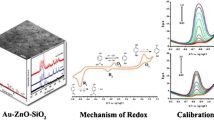Abstract
The authors describe a selective hydrazine sensor that is based on the use of a film of TiO2 nanoparticles faceted predominantly at the 101 and 001 sides. The hydrazine (Hyd) sensor was fabricated by depositing the nanoparticles in 5% concentration in a nafion matrix on a glassy carbon electrode (GCE). The sensor exhibits a fast response, excellent sensitivity and good selectivity over 1.0 nM to 10.0 mM. The sensor responds linearly to the logarithm of the concentration of dissolved hydrazine in the range from 1.0 nM to 10.0 mM, with a sensitivity of 35.04 μA.mM−1.cm−2. The detection limit is 28.8 ± 0.2 pM (at an S/N ratio of 3) is extremely low. In our perception, this approach emerges as an effective technique for develo** efficient chemical sensors for environmental pollutants.

Schematic presentation of a hydrazine sensor based on TiO2 nanoparticles placed on a glassy carbon electrode with 5% Nafion for the selective and efficient detection of hydrazine in environmental water samples.



Similar content being viewed by others
References
Casella IG, Guascito MR, Salvi AM, Desimoni E (1997) Catalytic oxidation and flow detection of hydrazine compounds at a nafion/ruthenium(III) chemically modified electrode. Anal Chim Acta 354:333
Gholivand MB, Azadbakht A (2011) A novel hydrazine electrochemical sensor based on a zirconium hexacyanoferrate film-bimetallic au-Pt inorganic-organic hybrid nanocomposite onto galssy carbon-modified electrode. Electrochim Acta 56:10044
Salimi A, Miranzadeh L, Hallaj R (2008) Amperometric and voltammetric detection of hydrazine using glassy carbon electrodes modified with carbon nanotubes and catechol derivatives. Talanta 75:147
Rastogi PK, Ganesan V, Krishnamoorthi S (2014) Palladium nanoparticles decorated gaur gum based hybrid material for electrocatalytic hydrazine determination. Electrochim Acta 125:593
Ballesteros JC, Chaînet E, Ozil P, Trejo G, Meas Y (2011) Electrochemical studies of Zn underpotential/overpotential deposition on a nickel electrode from non-cyanide alkaline solution containing glycine. Electrochim Acta 56:5443
Safavi A, Baezzat MR (1998) Flow injection chemiluminescence determination of hydrazine. Anal Chim Acta 358:121
Gawargious YA, Besada A (1975) Iodometricmicrodetermination of hydrazines by amplification reactions. Talanta 22:757
McBride W, Henry R, Skolnik S (1951) Potentiometric analytical methods for hydrazino compounds. Sydrazine Sulfate Anal Chem 23:890
Ikeda S, Satake H, Kohri Y (1984) Flow injection analysis with amperometric detector utilizing the redox reaction of iodate ion. Chem Lett 13:873
Safavi A, Ensafi AA (1995) Kinetic spectrophotometric determination of hydrazine. Anal Chim Acta 300:307
Golabi SM, Zare HR, Hamzehloo M (2001) Electrocatalytic oxidation of hydrazine at a pyrocatechol violet (PCV) chemically modified electrode. Microchem J 69:13
Maleki N, Safavi A, Farjami E, Tajabadi F (2008) Palladium nanoparticle decorated carbon ionic liquid electrode for highly efficient electrocatalytic oxidation and determination of hydrazine. Anal Chim Acta 611:151
Azad UP, Ganesan V (2011) Determination of hydrazine by polyNi(II) complex modified electrodes with a wide linear calibration range. Electrochim Acta 56:5766
Ivanov S, Lange U, Tsakova V, Mirsky VM (2010) Electrocatalytically active nanocomposite from palladium nanoparticles and polyaniline: oxidation of hydrazine. Sensors Actuators B Chem 150:271
Jayasri D, Narayanan SS (2007) Amperometric determination of hydrazine at manganese hexacyanoferrate modified graphite-wax composite electrode. J Hazardous Mater 144:348
Li J, Lin X (2007) Electrocatalytic oxidation of hydrazine and hydroxylamine at gold nanoparticle—polypyrrole nanowire modified glassy carbon electrode. Sensors Actuators B Chem 126:527
Li F, Zhang B, Dong S, Wang E (1997) A novel method of electrodepositing highly dispersed nano palladium particles on glassy carbon electrode. Electrochim Acta 42:2563
Haghighi B, Hamidi H, Bozorgzadeh S (2010) Sensitive and selective determination of hydrazine using glassy carbon electrode modified with Pd nanoparticles decorated multiwalled carbon nanotubes. Anal Bioanal Chem 398:1411
Batchelor-McAuley C, Banks CE, Simm AO, Jones TGJ, Compton RG (2006) The electroanalytical detection of hydrazine: a comparison of the use of palladium nanoparticles supported on boron-doped diamond and palladium plated BDD microdisc array. Analyst 131:106
Šljukić B, Banks CE, Crossley A, Compton RG (2006) Iron (III) oxide graphite composite electrodes: application to the electroanalytical detection of hydrazine and hydrogen peroxide. Electroanalysis 18:1757
Chen H, Nanayakkara CE, Grassian VH (2012) Titanium dioxide photocatalysis in atmospheric chemistry. Chem Rev 112:5919
Linsebigler AL, Lu G, Yates JT (1995) Photocatalysis on TiO2 surfaces: principles, mechanisms, and selected results. Chem Rev 95:735
O'Regan B, Gratzel M (1991) A low-cost, high-efficiency solar cell based on dye-sensitized colloidal TiO2 films. Nature 353:737
Etgar L, Gao P, Xue Z, Peng Q, Chandiran AK, Liu B, Nazeeruddin MK, Grätzel M (2012) Mesoscopic CH3NH3PbI3/TiO2 heterojunction solar cells. J Am Chem Soc 134:17396
Diebold U (2003) The surface science of titanium dioxide. Sur Sci Rep 48:53
Liu G, Yang HG, Pan J, Yang YQ, Lu GQ, Cheng H-M (2014) Titanium dioxide crystals with tailored facets. Chem Rev 114:9559
Wu B, Guo C, Zheng N, **e Z, Stucky GD (2008) Nonaqueous production of nanostructured Anatase with high-energy facets. J Am Chem Soc 130:17563
Vittadini A, Selloni A, Rotzinger FP, Grätzel M (1998) Structure and energetics of water adsorbed at TiO2Anatase101 and 001 surfaces. Phys Rev Lett 81:2954
Ponnusamy D, Prasad AK, Madanagurusamy S (2016) CdO-TiO2 nanocomposite thin films for resistive hydrogen sensing. Microchim Acta 183:311
Tian J, Yang G, Jiang D, Su F, Zhang Z (2016) A hybrid material consisting of bulk-reduced TiO2, graphene oxide and polyaniline for resistance based sensing of gaseous ammonia at room temperature. Microchim Acta 183:2871
**ong W, Liu H, Liu S (2015) Conductometric sensor for ammonia and ethanol using gold nanoparticle-doped mesoporous TiO2. Microchim Acta 182:2345
Ongaro M, Signoretto M, Trevisan V, Stortini AM, Ugo P (2015) Arrays of TiO2 nanowires as photoelectrochemical sensor for hydrazine detection. Chem Aust 3:146
Kim SP, Choi HC (2015) Reusable hydrazine amperometric sensor based on nafion-coated TiO2-carbon nanotube modified electrode. Sensors Actuators B Chem 207:424
Hu CG, Wang WL, Wang SX, Zhu W, Li Y (2003) Investigation on electrochemical properties of carbon nanotubes. Diamond Related Mater 12:1295
Dong B, He B-L, Huang J, Gao G-Y, Yang Z, Li H-L (2008) High dispersion and electrocatalytic activity of Pd/titanium dioxide nanotubes catalysts for hydrazine oxidation. J Power Sources 175:266
Pavela TO (1975) Hydrazine-platinum, a low-pressure hydrogen electrode. Suomen Kemistilehti 30B: 240.
Chen X, Wang Z, Wang X, Wan J, Liu J, Qian Y (2005) Single-source approach to cubic FeS2 crystallites and their optical and electrochemical properties. Inorg Chem 44:951
Zhang M, Chen B, Tang H, Tang G, Li C, Chen L, Zhang H, Zhang Q (2015) Hydrothermal synthesis and tribological properties of FeS2 (pyrite)/reduced graphene oxide heterojunction. RSC Adv 5:1417
Fabregat-Santiago F, Mora-Sero I, Garcia-Belmonte G, Bisquert J (2003) Cyclic voltammetry studies of Nanoporous semiconductors. Capacitive and reactive properties of Nanocrystalline TiO2 electrodes in aqueous electrolyte. J Phys Chem B 107:758
Wu J, Zhou T, Wang Q, Umar A (2016) Morphology and chemical composition dependent synthesis and electrochemical properties of MnO2-based nanostructures for efficient hydrazine detection. Sensors Actuators B Chem 224:878
Zhao Y-D, Zhang W-D, Chen H, Luo Q-M (2002) Anodic oxidation of hydrazine at carbon nanotube powder microelectrode and its detection. Talanta 58:529
Kumar R, Rana D, Umar A, Sharma P, Chauhan S, Chauhan MS (2015) Ag-doped ZnOnanoellipsoids: potential scaffold for photocatalytic and sensing applications. Talanta 137:204
Ni Y, Zhu J, Zhang L, Hong J (2010) Hierarchical ZnO micro/nanoarchitectures: hydrothermal preparation, characterization and application in the detection of hydrazine. CrystEngComm 12:2213
Liu J, Li Y, Jiang J, Huang X (2010) C@ZnOnanorod array-based hydrazine electrochemical sensor with improved sensitivity and stability. Dalton Trans 39:8693
Sultana W, Ghosh S, Eraiah B (2012) Zinc oxide modified au electrode as sensor for an efficient detection of hydrazine. Electroanalysis 24:1869
Han KN, Li CA, Bui MPN, Pham X-H, Seong GH (2011) Control of ZnO morphologies on carbon nanotube electrodes and electrocatalytic characteristics toward hydrazine. Chem Commun 47:938
Fang B, Zhang C, Zhang W, Wang G (2009) A novel hydrazine electrochemical sensor based on a carbon nanotube-wired ZnOnanoflower-modified electrode. Electrochim Acta 55:178
Zhang C, Wang G, Ji Y, Liu M, Feng Zhang YZ, Fang B (2010) Enhancement in analytical hydrazine based on gold nanoparticles deposited on ZnO-MWCNTs films. Sensors Actuators B Chem 150:247
Wang C, Zhang L, Guo Z, Xu J, Wang H, Zhai K, Zhuo X (2010) A novel hydrazine electrochemical sensor based on the high specific surface area graphene. Microchim Acta 169:1
Yi Q, Niu F, Yu W (2011) Pd-modified TiO2 electrode for electrochemical oxidation of hydrazine, formaldehyde and glucose. Thin Solid Films 519:3155–3161
Dong B, He BL, Huang J, Gao GY, Yang Z, Li HL (2008) High dispersion and electrocatalytic activity of Pd/titanium dioxide nanotubes catalysts for hydrazine oxidation. J. Power Sources 175:266–271
Acknowledgements
This project was funded by the Deanship of Scientific Research (DSR) at King Abdulaziz University, under grant No HiCi/2-130-36. The authors, therefore, acknowledge with thanks DSR for technical and financial support. We wish to thank the 42TEK S.L. (www.42tek.es) for furnishing us with the relevant titanium dioxide samples needed for this analysis. This work was supported by Generalitat Valenciana project PROMETEO/2014/020. VGA ackkowledges project NASCENT, ENE2014-56237-C4-3-R, from MINECO of Spain for finantial support. Serveis Central d’Instrumentació Científica (SCIC) from Universitat Jaume is acknowledged for AFM, TEM and DRX measurements.
Author information
Authors and Affiliations
Corresponding authors
Ethics declarations
The author(s) declare that they have no competing interests.
Electronic supplementary material
ESM 1
(DOC 1259 kb)
Rights and permissions
About this article
Cite this article
Rahman, M.M., Alfonso, V.G., Fabregat-Santiago, F. et al. Hydrazine sensors development based on a glassy carbon electrode modified with a nanostructured TiO2 films by electrochemical approach. Microchim Acta 184, 2123–2129 (2017). https://doi.org/10.1007/s00604-017-2228-x
Received:
Accepted:
Published:
Issue Date:
DOI: https://doi.org/10.1007/s00604-017-2228-x




